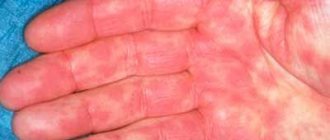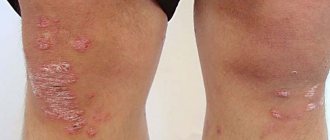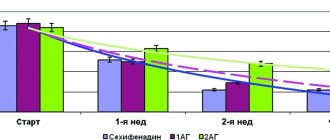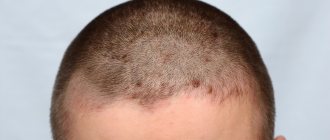Last update: 03/03/2021
The neck is one of the most sensitive areas of our body; the skin in this area is extremely susceptible to external influences, including those of an allergic nature. The appearance of allergies in the neck can cause unpleasant physical sensations and interfere with putting on clothes or taking a shower; In addition, psychological inconveniences associated with the manifestations of allergic reactions on open areas of the skin cannot be ruled out. This is why it is so important to know about the causes, symptoms and treatments for this disease.
Causes of neck allergies
Neck allergies can be caused by local exposure, or may be part of a systemic reaction to a particular allergen. Among the local causes that most often cause allergy symptoms on the skin of the neck are:
- Prolonged exposure to sweat (heat rash);
- Exposure to metal objects. Chains, necklaces, clasps and other items made of simple or precious metals may cause allergies when in prolonged contact with the skin;
- Cosmetics;
- External medications;
- Ultraviolet (usually in combination with other factors, for example chemicals).
In addition, neck allergies may be part of a systemic response to food allergens (fish, citrus fruits, berries, etc.), environmental factors (dust, pollen, microorganisms, wool), etc.
Allergic reactions
The appearance of allergic dermatitis on the cervical skin can be caused by the fact that the main epidermis is affected. The normal functioning of the immune system is disrupted, stressful situations may occur, and the skin may be injured. All this also often results in a rash on the neck.
The child sometimes produces insufficient amounts of enzymes, or the mother may consume foods during pregnancy that turn out to be food allergens. When spots appear on the skin with a red or pink tint, which subsequently transform into blisters, this is considered the main signs of allergic dermatitis.
Then the blisters begin to burst, causing weeping sores to form. Because of this, a person suffers from a burning sensation, and the skin itches not only where the formations appeared, but also on other parts of the neck. These symptoms are similar to signs of possible eczema, but the nature is not as pronounced.
If we talk about contact dermatitis, it is a reaction of the human body to the contact of an irritant with the skin. Inflammatory elements may appear due to the influence of:
- Alkalis;
- Detergents;
- Acids and so on.
The manifestation of the erythematous form can be expressed in the form of swelling, excessive dryness, as well as the appearance of cracks in the skin. Bullous varieties of the disease can include phenomena such as a watery rash that appears in the form of blisters containing serous fluid. Necrotizing contact dermatitis causes severe ulcers to form and become scabby. When they heal over time, they usually leave visible scars.
Common symptoms and manipulations in dermatology:
- Skin rashes
- Calling a dermatologist to your home
- Itching in the urethra
- Itchy skin
- Skin rash
- Prevention of casual sex
- Skin neoplasms
- Pyoderma
- Pityriasis rosea
- Streptoderma
- Scabies
- Peeling skin
- Fungal infections
- Skin infection
- Pus on the skin
- Blisters on the skin
- Papillomas on the foreskin
- Sexually transmitted diseases
- Skin structure
Allergy treatment
The basic principle of treating any allergic reaction is to eliminate the causes that caused it. In addition, patients are often prescribed a special elimination diet to protect themselves from food allergens. In the treatment of allergies, anti-allergic and anti-inflammatory drugs of local and systemic action are also used.
Of great importance in the treatment of allergic reactions is the elimination of the most unpleasant symptoms: redness, burning, itching. La-Cri products, compatible with modern anti-allergy drugs, can help with this:
- La-Cri cream reduces burning and itching, helps reduce erythema (redness);
- Emulsion "La-Cri"
allows you to make the skin less sensitive, get rid of flaking and dryness; - Cleansing gel "La-Cri"
allows you to cleanse the skin of irritants and allergens.
Experts' opinion
The conducted clinical study proves the high efficiency, safety and tolerability of products for daily skin care of children and adults with mild and moderate forms of atopic dermatitis and during remission, accompanied by a decrease in the quality of life of patients. As a result of therapy, a decrease in the activity of the inflammatory process, a decrease in dryness, itching and flaking was noted.
Based on the results of joint research, the following information is placed on product packaging: “Recommended by the St. Petersburg branch of the Union of Pediatricians of Russia.”
Sources:
- Yukhtina N.V., Modern ideas about atopic dermatitis in children
- Kamasheva G.R., Khakimova R.F. Valiullina S.A., Methods for assessing the severity of atopic dermatitis in young children, Dermatology journal, 2010
- G.V. Molokova, E.V. Bukina, Diaper dermatitis in children with sensitive skin, Journal of Dermatology and Allergology, 2019
- N.L. Rybkina, Modern approaches to newborn skin care: pediatrician tactics, journal Bulletin of Modern Clinical Medicine, 2014
Photosensitive dermatoses: treatment and prevention
Despite a sufficient number of publications devoted to photodermatoses, dermatologists pay little attention to this problem. The term “photodermatosis” refers to an excessive reaction of the skin to light, usually solar radiation. There is no single classification, but it is generally accepted to divide photodermatoses into acute and chronic. In acute photodermatoses, phototoxic and photoallergic reactions to sunlight are distinguished. These reactions are caused by the combined action of sunlight and a chemical (plants, medications, cosmetics, etc.). In the first case, reactions can develop in any person and occur like a sunburn (erythema, swelling, blisters followed by hyperpigmentation), and in the other, they are observed only in sensitized people, are mediated by immune mechanisms and are clinically expressed by rashes in the form of papules, vesicles, weeping etc.). Finally, idiopathic photodermatoses can be acute; these include reactions to salt light, united by the general collective term “polymorphic photodermatosis,” in which it is not possible to establish the cause of the disease. For all photodermatoses, the most susceptible areas of the skin are places exposed to the sun: the face, ears, neck, décolleté, dorsum of the upper extremities, where rashes are usually localized.
Chronic photodermatoses are characterized by a variety of clinical manifestations of long-term exposure to sunlight, leading to premature aging of the skin (solar keratosis, senile lentigo, actinic reticuloid
and so on.). The severity of clinical manifestations is directly related to the cumulative effect of ultraviolet rays (UV). First of all, people who are exposed to direct sunlight for a long time suffer (due to working outside, regular sun exposure, living in southern geographic zones, especially when it comes to people with phototypes I–III). Recently, the role of tanning has been especially noted in the development of the disease.
Today, everyone is well aware that excessive exposure to sunlight is harmful to our skin. Dermatologists and cosmetologists have always argued that ultraviolet radiation is the worst among all external factors.
Sun tanning began to be considered a symbol of health only after the industrial revolution. Before this, pale skin was “valued” as evidence of wealth, well-being and the absence of the need to work outside the home and expose one’s body to the sun. But the industrial revolution came and the attitude towards tanning changed: on the contrary, tanned skin became a symbol of well-being - after all, a person living in abundance has a lot of time to spend in the fresh air and sun. Tanning became firmly in fashion in the 40s. XX century - at the suggestion of the French fashion trendsetter Coco Chanel. But people began to associate sun tanning with health earlier, in the early 1900s, when they proposed a method of treating sun rays called heliotherapy, and until the 40s and 50s. XX century the doctors sincerely believed that everyone could be treated in this way.
The popularity of sun tanning as a sign of health, well-being and fashion lasted for several decades, and no one doubted the benefits of tanning. Indeed, sunbathing has an excellent strengthening effect: metabolism increases, the functioning of the endocrine glands improves, the amount of hemoglobin increases, vitamin D is synthesized (it is especially important during pregnancy to prevent rickets in the fetus, as well as to prevent osteoporosis in the elderly). Sun rays have a pronounced antidepressant effect, they contribute to positive dynamics in the treatment of psoriasis, atopic dermatitis, various forms of ichthyosis, etc. However, the rapid spread of skin cancer and the decrease in the ozone layer in the last few years have cast doubt on the indisputability of the benefits of tanning. A difficult “anti-tanning campaign” has begun: over the past decades, people have firmly believed in the benefits of tanning, and it turned out to be difficult to convince them. For several decades, most members of the white race found tanned skin particularly attractive; tanning was associated with health, relaxation, sports, success, but over time, tanning began to go out of fashion, at least tanning at any cost. Nowadays, many people are already aware of the need to protect their skin from the sun and the danger of skin cancer, and yet most people are convinced that tanning is more beneficial than harmful.
Of course, without UV rays life on Earth is impossible - this is a well-known fact. Since the times of Ancient Egypt, the sun has been deified as the giver of vital energy “ankh”, leading every person through earthly life and accompanying the chosen ones in the afterlife.
What is UV radiation and how can its such contradictory effects on the human body be explained? Sunlight consists of rays of different wavelengths: UV radiation, infrared and visible radiation. The most dangerous of them in terms of skin damage and the need for protection is UV radiation, which is divided into UVA (320-380 nm), UV-B (280-320 nm) and UV-C (200-280 nm). UV-C is the radiation most harmful to flora and fauna, but it is mostly absorbed by the ozone layer in the stratosphere and does not reach the earth's surface. For quite a long time, the main attention was paid to UVB rays, the action of which is based primarily on the dilation of blood vessels in the dermis, but the main changes caused by them take place in the epidermis. UV-B rays are responsible for the appearance of sunburn, which, in turn, can cause skin cancer in these areas in the future.
However, the cumulative effects of UV-A rays can cause much more harm than UV-B. Although UVB rays have 1000 times the energy of UVA, 90% of UVB rays are blocked by the stratum corneum of the epidermis, while 50–60% of UVA rays are able to penetrate deep into the skin . Thus, penetrating into the papillary and reticular layers of the dermis, these rays reduce its elasticity and firmness, causing the appearance of wrinkles, folds, pigmented and keratotic rashes as a result of premature aging of the skin. It is important to note that signs of photoaging can be observed long before the symptoms of age-related skin aging appear, but these changes appear only in exposed areas exposed to sunlight (neck, décolleté, face, forearms and hands). Most clinical manifestations are due to dermal changes.
Spectrum A rays act mainly indirectly, promoting the production of free oxygen radicals, which, in turn, activate lipid peroxidation, transcription factors and can lead to breaks in deoxyribonucleic acid (DNA) chains. At the same time, UV-B rays, which are also to some extent capable of producing free forms of oxygen, mainly have a direct damaging effect on DNA through the direct activation of transcription factors: activating protein (AP-1) and nuclear factor (NF-kB). These factors trigger the production of metalloproteinases in the cell—enzymes that have high proteolytic activity against cell building proteins.
There is another group of photodermatoses, which can be acute and chronic; these include porphyria (late cutaneous, variegated, erythropoietic protoporphyria), pellagra, xeroderma pigmentosum and dermatoses aggravated by exposure to sunlight (lupus erythematosus, actinic porokeratosis, rosacea, herpes, etc.).
A very important aspect of the negative impact of sun rays is also malignant skin tumors. The greatest concern among dermatologists and oncologists is the steady spread of melanoma, the most dangerous malignant skin tumor, which accounts for 2% of all cancers. This is especially true for children and young people with phototypes I and II (blond and red-haired people who always burn in the sun, but never tan or tan with difficulty). As the ozone layer of the atmosphere has become thinner in recent decades, scientists predict a significant increase in the incidence of skin cancer.
There is no doubt that there is a direct connection between the total amount of UV radiation and the incidence of skin cancer. Let us present some facts confirming this thesis.
- 95% of all skin cancers develop in areas of the skin that are constantly exposed to sunlight (the face and neck).
- White-skinned people who spend a lot of time outdoors and in the sun are much more likely to get skin cancer than office workers.
- In Asia, where white skin is considered beautiful and residents do not enjoy sunbathing, skin cancer is rare.
Regardless of the pathogenesis of a particular disease, the main triggering factor in the development of these conditions is the perverted reaction of the skin to UV radiation, therefore the entire range of therapeutic and preventive measures should be aimed at protecting from sunlight. The skin has its own defenses. With UV irradiation, processes begin to occur in it aimed at protecting against the damaging effects of rays: the stratum corneum thickens (at the same time, UVB rays are absorbed in the stratum corneum), pigmentation increases, and a tan appears (induced melanin pigmentation). Indeed, for most people, tanning is a fairly effective means of protection from sun rays, but provided that the exposure to the sun on the skin is not too long and the skin has time to recover, since the skin’s natural defense mechanisms are not immediately activated. In addition, there is constitutional melanin pigmentation, which determines the color of a person’s skin and has six types: the more melanin, the darker the skin and the higher the degree of protection from exposure to sunlight. Accordingly, photodermatoses often affect people with white skin who do not tan at all or tan with difficulty.
Moving on to the treatment of photodermatoses, let us recall some very important recommendations: first of all, stay in the sun as little as possible, change jobs if necessary, do not sunbathe in direct rays, constantly use photoprotective agents, be careful with medications that have a photosensitizing effect (tetracyclines - doxycycline, tetracycline; sulfonamides; contraceptives; antifungals - griseofulvin; neuroleptics; diuretics - furosemide; psoralens; non-narcotic analgesics - naproxen; etc.). Foods containing furocoumarin, such as lime, figs, parsley, mustard, carrots and celery, also contain photosensitizing substances and can aggravate the disease, as can the use of excessive amounts of perfume, especially at the beach.
The main goal of therapy for all types of photodermatoses is to reduce photosensitivity, therefore the first-line treatment for patients is drugs with photodesensitizing properties. These include drugs of the quinoline series (delagil and plaquenil), β-carotene, para-aminobenzoic acid (O. L. Ivanov, 1997). For porphyrias, it is advisable to prescribe nicotinic acid, which is part of the coenzymes nicotinamide adenine dinucleotide and nicotinamide adenine dinucleotide phosphate, and takes part in redox processes, reducing the content of porphyrins in the blood. In addition, complex therapy for photodermatoses includes vitamins A and E, which are powerful natural antioxidants that protect various substances from pathological oxidation reactions. The use of antioxidants is also possible in cosmetics: extracts of grape seeds, green tea, ginkgo, chamomile, maritime pine bark, blue cornflower, calendula officinalis.
External treatment depends on the severity of the inflammatory reaction and includes various means - from lotions to anti-inflammatory ointments, including corticosteroids. In order to more actively reduce the degree of photosensitivity, enterosorbents, hemosorption and plasmapheresis are prescribed.
The range of bleaching agents for lentigo for topical application is not so large. These include azelaic acid, arbutin, licorice extract and other substances of plant origin, ascorbic acid, hydroquinone, kojic acid, topical corticosteroids (low-potency, i.e., weak action), retinoids, rucinol (M. V. Khaldina, M. V. Cherkasova, 2005).
Taking into account the morphological changes that occur in the skin during chronic photodermatoses, the efforts of dermatologists are mainly aimed at helping the skin return to its normal state. Since the mid-80s. XX century The most popular means in the fight against photoaging are phenol (deep peeling) and trichloroacetic acid (medium peeling), which at the dermal level stimulate fibroblast proliferation and slow down collagen degeneration. These techniques are still relevant today. But in the 1990s, the attention of dermatologists was attracted by α-hydroxy acids - glycolic, lactic, citric, tartaric, malic. Glycolic acid, which penetrates well into the dermis, is most often used to treat skin damaged by UV radiation. By using a high concentration of glycolic acid (50–70%) during peeling, you can achieve not only an exfoliating effect, but also stimulate fibroblasts with a significant increase in collagen production.
Skin exfoliation can be carried out using hardware methods - using dermabrasion and laser resurfacing. However, these procedures are quite expensive and should only be performed in medical institutions.
Mesotherapy using mesotherapeutic drugs such as hyaluronic acid, placenta and fetal tissue extracts, and nucleotides (X-ADN) is considered a very promising method.
Currently, the technology of intense pulsating light, used in the fight against photoaging and based on the technique of selective photothermolysis, is of great interest. A powerful pulse of light generated by a xenon flash lamp is pre-filtered to remove dangerous UV radiation and transmitted using a sapphire crystal to a fluorescent filter, which, depending on the “impregnation” with special substances, can transmit and additionally emit waves in the range from 535 to 1000 nm . This uses filtered light that is enhanced in a certain part of the spectrum due to the fluorescence effect. This light, depending on its wavelength, affects melanin, hemoglobin and collagen. Clinical trials have shown that selectively heating dermal collagen to 55°C causes continued formation of new collagen. An increase in collagen synthesis begins 8–10 weeks after the last session and continues for 6–12 months. The biochemical mechanism of the method is based on photothermal stimulation of fibroblasts, which begin to actively synthesize collagen.
The main role in the prevention of photodermatoses belongs to photoprotective agents, which must meet strict requirements, namely, absorb rays over a wide range, be resistant to light, heat, water, have low penetrating ability through the stratum corneum, be safe, not toxic, carcinogenic, or sensitizing. action, effectively prevent the appearance of visible (sunburn) and invisible (photoaging, photodermatoses, carcinogenesis) effects of UV radiation.
Sunscreens contain physical or chemical filters that block the sun's rays. Physical are mineral compounds of titanium or zinc; they remain on the surface of the skin and, like small mirrors, block solar radiation by reflecting the rays. Chemical filters capture UV rays and convert them into heat that is harmless to the skin. The latest generation of filters protects the skin not only from UV-B, but also from UV-A rays. The main criterion when choosing a particular photoprotective product is the sun protection factor (SPF).
In 1956, M. Schulze introduced the concept of solar protection factor and established it as the ratio of the minimum erythemal dose (MED) of skin protected by a UV filter to the MED of unprotected skin after 24 hours of irradiation (MED was assessed visually). A solar protection index of 60, for example, means that the UV dose required to produce erythema with protection is 60 times greater than without protection. However, using a filter with an index of 60 does not imply 60 times longer exposure to the sun.
For several years now, a series of preparations, Photoderm MAX, with a maximum solar protection factor (SPF) of 100, has been used for the treatment and prevention of photosensitive dermatoses, indicating how many times this product increases the natural protection of the skin. These drugs were developed by the French specifically for the prevention and treatment of photodermatoses and for use in patients who, for various reasons, cannot tolerate exposure to sunlight. At the same time, the advantage of this series is the presence of photoprotective products for any skin type (a cream is produced for normal and dry facial skin, an emulsion for oily skin, a milk for the body, and a foundation for dyschromia, such as vitiligo). One of the advantages of the Photoderm MAX series preparations can be considered the presence in them of a previously unused organic screen “Tinosorb M”, which absorbs sunlight as an organic filter without penetrating the skin, and reflects them as a mineral screen, providing optimal photoprotection from UVA - and UV-B rays.
In addition to the indicated series of drugs, a series of products with high protection against UV-A and UV-B rays, Antgelios, from the French pharmaceutical laboratory La Roche-Posay, can be used. The products are based on La Roche-Posay thermal water and include the Anthelios MEXORYL SX and MEXORYL XL filter system, which provide optimal protection against UV rays and prevent damage to the body associated with solar radiation.
A sun protection range with thermal water from the Aven dermatological laboratory is also used, including products for sensitive and hypersensitive skin (not tolerant of chemical filters and aromatic fragrances) for children and adults. The series contains new generation MPI-SORB screens that protect the skin not only from short UV-A and UV-B rays, but also from long UV-A rays, which have a detrimental effect on the deeper layers of the skin.
In conclusion, I would like to note that you need to treat your health as a gift that must be protected, not forgetting the need for a “reasonable” attitude towards the sun and the use of photoprotective agents.
O. Yu. Olisova, Doctor of Medical Sciences, Professor of MMA named after. I. M. Sechenova, Moscow










